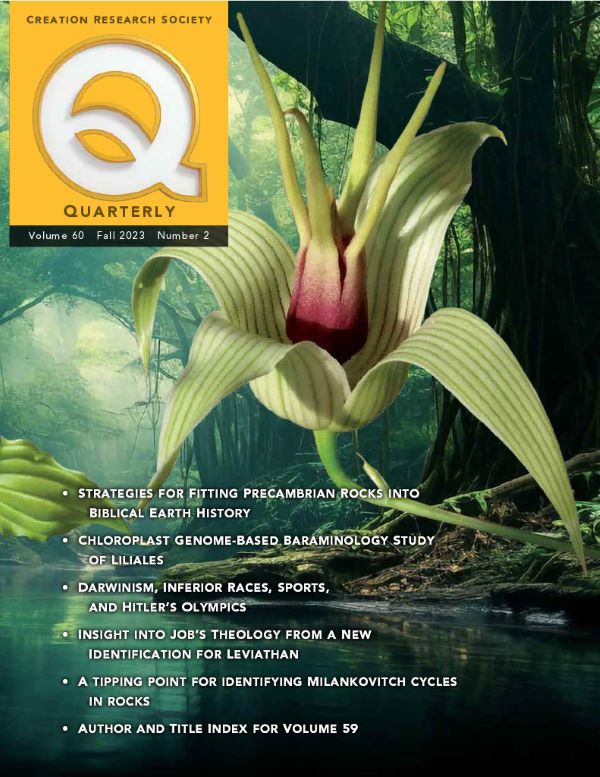
ABSTRACTS
Insight into Job's Theology from a New Identification for Leviathan
Brian Thomas and Daniel A. Biddle
Prior work identified a sauropod as Job's behemoth. Although not possible from the standpoint of secular history, Biblical Creation positions the majority of Earth's fossils as deposits from Noah's Flood. As with the behemoth, it thus opens the possibility of identifying Job's leviathan (Job 41) as an extinct creature. Arguments in favor of Job's leviathan as a real animal are presented. Next, features from four candidate animals are compared with anatomical and behavioral hints from Job 41. We find that a new description of an extinct non-dinosaur reptile named Deinosuchus offers heretofore unknown anatomical details that commend it as a top candidate for a literal leviathan. Finally, a few theological implications of identifying Job's leviathan as a historical animal are explored.
Chloroplast Genome-Based Baraminology Study of Liliales (Open Access)
Matthew Cserhati
The mitochondrial DNA has been used widely in molecular baraminology studies. Besides the mitochondrion, the chloroplasts of plants harbor an entire organelle genome, which can also be used to identify putative groups, which can be compared to those identified in studies based on mitochondrial DNA, nuclear DNA, and morphological characters. The ten-fold size of the chloroplast genome allows a much larger sequence space to be analyzed, but it also brings its own set of analytical challenges to the table.
In this study, the chloroplast genomes of 163 species from the plant order Liliales were examined, with the genus Stemona (order Pandanales) as an outgroup. A multiple alignment was created, and a sequence similarity matrix was derived from it, which was then clustered into several putative holobaramins. Of these, six groups had more than five members. These putative baramins are: Tulipa+Amana, Disporum, Fritillaria+Lilium+Nomocharis+Notholirion, Daiswa+Paris+Trillium, Smilax, and Veratrum .
Compared to the results of a previous morphological analysis, there are some discordances. The previous analysis separates Trillium from Daiswa and Paris, and unites Alstroemeria with Disporum. Ultimately, genetics should decide baraminic classification, albeit the chloroplast genome still makes up only a small fragment of the entire plant genome. Following this study, it is hoped that chloroplast genome analysis may enrich the toolkit of molecular baraminology.
Suggested Strategies for Fitting Precambrian Rocks into Biblical Earth History
Michael J. Oard, John K. Reed, and Peter Klevberg
A comprehensive Flood model requires an appraisal of the rock record. At the global scale, knowing the global volume and distribution of such rock is an important first step. This requires significant mapping and quantifying of rock volume, which in turn requires determining basal and upper diluvial boundaries for each location. An important question in determining basal boundaries is how to address Precambrian sedimentary and volcanic rocks. We present strategies for evaluating such rocks vis a vis the Genesis Flood, concluding that many such rocks should be considered diluvial.
Darwinism, Inferior Races, Sports, and Hitler's Olympics
Jerry Bergman
Historically, Black people have excelled in certain sports. This fact produced a problem for Darwinists since they believe that an 'inferior race' cannot be physically (or mentally) superior to other races. To resolve this contradiction, it was believed that since those with black skin were less evolved, their bodies retained 'animal bestial athletic abilities.' Thus, they were better at athletics. Nazi Germany embraced this explanation as the "solution" to this contradiction. Ultimately, this belief found its way into the United States. The racism that Darwin produced resulted from a rejection of the clear teaching of Scripture that all humans were descended from the first couple as described in Genesis. The Biblical truth is only one race exists, the human race.
Notes from the Panorama of Science: A Tipping Point for Identifying Milankovitch Cycles in Rocks
The geological literature is well-supplied with papers claiming that the timescales for the sedimentation of many layered rocks has been determined objectively. Researchers have identified patterns in rock formations that correlate with known astronomical cycles. The cycles relate to orbital precession (P), obliquity (O), and orbital eccentricity (E). These are known as the Milankovitch cycles, which in theory affects the distribution of sunlight on Earth over many thousands of years and controls the timing of presumed glacial cycles.
Many geologists have devoted their careers to cyclostratigraphy, which is the name given to the identification of astronomical signals in sedimentary sequences. Over past decades, this approach has been an essential part of the toolbox used by sedimentologists analysing data from Quaternary and Neogene sources, and sometimes even "older" layers. In the 1990s, cyclostratigraphy was used to match orbital cycle chronologies with measured sedimentary cycles and oxygen isotope curves. According to the textbook by Weedon (2003, p. 3):
